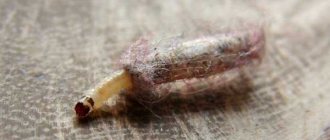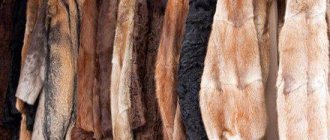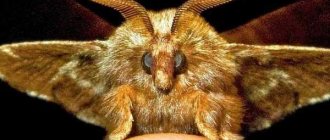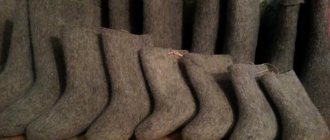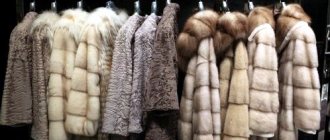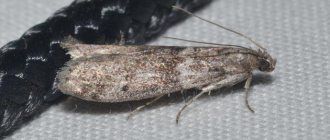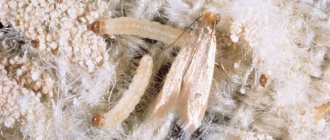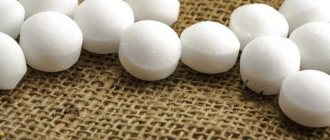How dangerous are moths?
Moth loves to wear natural fur.
Moths feed on keratinized particles or keratin that remains on fur products. She, of course, is not able to eat the entire fur coat, but she can spoil it so that it is no longer suitable for wear.
If there is a large concentration of insects, they will happily move from a mink coat to woolen items, leather shoes, carpets or even furniture upholstery.
You can read more about the clothing moth, which so loves to wear fur items dear to a woman’s heart, at the link.
Description of the fur moth
There are many types of moths: clothes moth, food moth, clothes moth, grain moth. But today we will talk about the type that most upsets the female half of humanity. This is a fur moth or as it is also called a house moth. This insect feeds mainly on furs. The caterpillars are white, worm-like , naked, with eight short legs and a brown head; the body is translucent so that the insides can be seen.
The adult is sand-colored, the wings are transparent with dots in the middle, the span is about 14 - 17 mm. They live in portable cases . The adult does not have a mouthpart, so it does not feed. But it hatches larvae , which in turn spoil things. Also, female moths do not use their wings, that is, they do not fly. But the flying insects that irritate us are males. House moths are keratophages, that is, they feed on keratin , a substance that is part of the villus at the molecular level . It contains the very protein necessary for the life of an insect.
Stages of pest development
Insect development occurs in several stages:
eggs in a dark, secluded place, for example, in a closet .
From them appear moth caterpillars , which by the time their presence is noticeable, will make a bald spot in the fur coat.
The caterpillar, when it has eaten enough and finds a secluded place, will turn into a pupa, and butterfly .
Moths in a city apartment can reproduce all year round. The normal life cycle of the pest lasts no more than 90 days.
Symptoms of infection
Symptoms of moth infestation of a fur product are visible to the naked eye. The surface of the fur loses its attractiveness due to the formed lumps. Gradually, the paths and furrows eaten away by the larvae become clearly visible. The presence of pests is also indicated by the fur pile cut by them, as well as clearly visible “bald patches” on the surface of the fur product.
A moth in a fur coat does its dirty work catastrophically quickly, and any delay risks the fact that the fur coat will be irrevocably damaged.
Methods of protection
Fur moth.
The most important condition for protecting a fur coat is to monitor its hygiene. Outerwear to be stored in the closet should be free of dirty and greasy stains.
It is in such places that moths first appear. To keep a fur product clean, every housewife will find a suitable cleaning product for her fur coat.
A remedy proven by many is naphthalene. Although it helps protect clothes, its heavy smell will follow you everywhere, so it is better to avoid it. There are other proven remedies for moths.
Separate wardrobe
The ideal option is a separate wardrobe for fur.
Cleaned outerwear can be stored in a wardrobe specially designated for fur coats and other fur products. There they should be hung freely and not touch other things.
But this method of storage does not guarantee that moths will not get to the fur. Folk remedies will help protect it. You can put sachet of orange peels or lavender, fresh geranium leaves or a piece of strawberry soap in your wardrobe.
Branded stores have special refrigeration chambers for storing fur. They maintain ventilation, special humidity and temperature.
Aerosols
Folk remedies can scare moths away from the product. But a more effective remedy is aerosols labeled “anti-mole”. With its help you can treat the walls of the closet and the fur coat itself. It is imperative to monitor the re-processing deadline. Information about this is on the can of the product.
What are the best anti-moth products?
ChemicalFolk
Fumigators
This device will protect the fur coat for a long time against moths, as well as their eggs.
A special bottle with a plug is connected to an outlet; under the influence of temperature, the liquid evaporates, and the moths and larvae die. This method will not only protect the fur product from moths, but will also help preserve the entire house.
It is important to remember to update your scent repellents. They are completely imperceptible to the human sense of smell, but have an excellent effect on pests.
Case and control
Case for storing fur coats.
Not every housewife can afford a separate wardrobe for fur, so a case is suitable for storage, in which it is important to put the product away and hang it in the closet. But as a preventative measure, you can purchase a case impregnated with a special product.
After purchasing, the item must be carefully inspected. The fur should be shiny, smooth, without bald spots.
In winter, when worn, the fur coat is not threatened by moths: it and its larvae die in the cold. The product needs special attention during storage. Regularly check the condition of the product during storage.
The first signs of the presence of moths
One moth larva can “gnaw through” an entire centimeter of fabric in just a day! Therefore, in order to protect your fur coat, it is worth carefully inspecting it from time to time.
At the first sign of moths, emergency assistance is necessary. Here are some of the main obvious signs of moths on a fur coat:
• The fur is crumpled, looks dull and untidy; • There are several hairs of wool on the floor of the wardrobe; • Crumpled fur on the smooth surfaces of a fur coat; • Slightly stale smell from the product; • When ironed by hand, the villi fall out; • Small bald patches and spots are visible in the curves.
If you detect at least one such symptom, urgently free the fur from these “inhabitants”, since in the near future you risk being left without warm protection for the winter.
Actions to take if a fur product is contaminated
A product can become infected during storage in the warm season or if there are larvae in the closet or room where it is stored.
Signs of infection
The signs are easy to spot, as they are immediately obvious. This:
- A fur coat affected by moths loses its attractive appearance and lumps form on the surface.
- The folds and wrinkles that form are paths cut by the larvae.
- Trimmed fur pile.
- Formed bald patches on the surface.
- Presence of butterflies in the room where the product is located.
If you notice one or more of these signs, it is important to take action.
How to save a product
There are several ways to save a fur coat damaged by moths. If the situation is not critical:
- You can tint your bald spots to match the color of your fur.
- A small “bald spot” can be cut out, and the edges from the inside can be sewn together again.
- A spot in the chest or collar area can be decorated with a brooch.
- In some situations, you can shorten the product or cut off the sleeves and make a fur vest.
How to quickly kill insects
Raptor from moths.
Fur owners need to know what to do if moths have already appeared. It is necessary to destroy the larvae as quickly as possible. For this purpose, anti-moth products for fur coats are suitable, which can destroy insects in a matter of hours.
After treating your fur coat with insecticidal agents, you need to put it in a plastic bag for several days. You can use dry cleaning services, where the product will be processed at high temperatures.
Insecticides and aerosols are effective. In special stores you can choose for every taste and budget. Raptor extramit, Armol, Clean House have proven themselves well.
Story. Means and preparations for fur coats against moths
Owners of mink and sable coats, owners of arctic foxes and squirrels, owners of nutria, muton and fox: what to do in the summer, how to store and preserve a fur coat from moths correctly.
What to do if moths start eating your fur coat? Don’t waste time - use insecticides, the action of which should be directed both at the imago and at the caterpillars and eggs.
Among the chemical remedies:
- fumigators;
- "anti-moth" tablets;
- heating plates;
- insecticide aerosols, gels, sprays.
Experts recommend the following insecticides:
- Antimol Stop, Morpheus;
- Raid;
- Mosquitall;
- Raptor Moth protection;
- Clean house;
- Extramit;
- Combat;
- Armol.
And - many other insecticidal drugs.
By the way. Special cases are not only convenient for storage: they are impregnated with an aroma that repels insects, and are even manufactured by companies such as Raptor.
The following remedies will also help protect your fur coat from moths:
- Hanging sections, bags, sachets - repel with smell, sometimes impregnated with insecticides that spread throughout the closet and kill midges, attracting repellents. One or two sachets are enough to protect 1-2 m, the validity period is 3-6 months.
- Plates, hanging sections, paper hangers are means of protection and destruction impregnated with insecticide and fragrance. They affect larvae and are active against adults.
- Tablets - from those created on the basis of natural oils of lavender and geranium to those containing powerful insecticides.
You can also use a fumigator - a means of protecting the wardrobe and its contents. Serves for prevention, but will also help get rid of moths that have settled in a fur coat. The device is connected to an electrical outlet, evaporates substances poisonous to insects for a long time, but it is used no more than 2 times a month.
Among the well-known products are the products Raptor, Clean House, Armol, Raid. SuperBat, Combat, dr. Claus, Brownie Proshka, Taiga, etc.
How to treat a product with an insecticide: procedure.
- The product is vigorously shaken to free it from poorly attached larvae. It is important to do this in an open space, not in an apartment - on a balcony, for example.
- Place in a hermetically sealed plastic bag.
- Treat with an aerosol and quickly close.
- The treated clothing is usually removed after a day, two or four times, according to the instructions.
- Thoroughly clean and ventilate.
Before spraying, it is important to thoroughly remove larvae and eggs. After processing, the product is placed in a case, in a well-treated and ventilated cabinet. It is important to sanitize the storage area: there may be larvae and eggs in the cracks, on the shelves, on the floor.
To remove insects as efficiently as possible:
- Before processing, shake the fur coat and leave it in the sun for 5-6 hours - preferably at elevated temperatures.
- If damage is noticed in winter, the fur can be “frozen”: at sub-zero temperatures, some of the larvae may die or become detached from the fur. Despite their resistance to low temperatures, gnats do not like frost and sun.
Dry cleaning will be a 100% effective method: it will get rid of the pest, as well as eggs and larvae - which is not always guaranteed at home.
Home and folk remedies
Folk remedies can protect a fur coat or even banish it. Often the control is preventive in nature, but this is for the best: the use of insecticides is a last resort.
- Tobacco. Dry tobacco is placed in a small fabric bag that allows the smell to pass through, and placed in a closet or in clothing covers.
- Mint. Dried mint and lemon balm are not capable of removing or expelling a large colony forever - but they will certainly scare away individual individuals. And - they will warn the check-in. Dry twigs are placed in pockets, on shelves, in cases.
- Lavender, hops, tansy, cloves, St. John's wort - have a repellent effect and are used in a similar way.
- Citrus zest will repel with a sharp aroma no worse than mint, but for a pronounced effect, use a large amount of orange and lemon peels.
Naphthalene. This ancient remedy is still effective today. And to avoid annoying persistent and pungent odor, use dry mustard: it turns out that the powder placed in a linen bag helps reduce its intensity.
Of course, mustard will not completely eliminate the unpleasant aroma - but, according to reviews, it makes it much less repulsive.
Preparing fur coats for storage at home
- The product is sent for storage in its pure form.
- The fur coat must be thoroughly dried and brushed with a special fur brush. It is better to take a heavily soiled item to the dry cleaner.
- Before hanging in your wardrobe, you can leave it in the sun for a few days, if possible.
- Pests equally do not like high temperatures and frosts.
- It is best to store the product in a case and hang it on hangers of the appropriate size.
- Place moth repellents in the closet. Close wardrobe doors tightly.
Why does it appear?
The reason moths appear in the house is that they feel truly comfortable here. The insect is completely satisfied with the air temperature, humidity, and most importantly, with a sufficient amount of a wide variety of food necessary for the fully formed caterpillar to make a cocoon for itself, turn into a butterfly and lay eggs.
Moths appear on fur coats and other fur products due to non-compliance with care rules. During wear, particles of sweat and dirt remain on the product - exactly what the moth larva needs for successful development.
How to detect moths on a fur coat?
It is almost impossible to detect fur moth offspring in fur products at an early stage. Moth eggs are almost invisible to the eye due to their microscopic size and translucency. With the help of a special adhesive liquid, they attach to the hairs, successfully developing into larvae, which begin to actively eat someone's mink coat.
A visual inspection is effective only when obvious damage to the product is already noticeable: lumps, folds, tunnels among the fur pile, bald spots, hairs at the bottom of the cabinet, as if neatly and evenly cut.
Where do larvae come from?
The main sign of pests is flying through the cabinets and throughout the apartment. Defects can only be detected when worn, when tears can form in damaged areas and fabrics can unravel.
Before purchasing, a fur coat should be examined for the presence of fine traces of lint. When you arrive home, you need to hang your purchase on the balcony. Ventilate items only in warm weather. It could be a warm sunny day or even a winter frost.
The sun and air drive out possible insects.
Many people are interested in where moths come from? Items brought into the house must be inspected for the presence of parasites. The insect enters the house already on objects purchased in stores, in the form of invisible larvae, or even on the fur of dogs or cats. Pests that get into the house begin to eat fabric and other objects.
In which case should you store a mink coat?
A good quality bag will ensure proper storage of clothes and protect against moths, dust and ultraviolet radiation. A fur coat must breathe, so a plastic bag will not work. In addition, it transmits ultraviolet radiation, and this has a detrimental effect on the fur.
The cover should be made of natural and opaque material. Models made of linen, cotton and canvas are suitable.
This cover allows air to ventilate
You should buy a cover according to the size of the fur coat, but not one-to-one. It should hang freely and not come into contact with the pile. A properly selected product will not allow the pile to become deformed or wrinkled. The cover should be at least 15 cm larger than the mink coat.
Protective covers
When storing fur items for the summer, you need to put them in a protective cover. When purchasing a fur coat in specialized stores, such a cover usually comes included, but it can also be purchased separately.
Here we are not talking about a plastic bag, but about a special zippered cover made of air-permeable material. If you pack a fur coat in polyethylene or airtight synthetics, the product will acquire an unpleasant odor and the fur will lose its attractive appearance.
We suggest you read: How to treat your house for cat fleas
Before packing in a case, the fur coat must first be prepared for storage:
- remove all jewelry and accessories;
- check the quality of fasteners (buttons, snaps, hooks) and the integrity of the lining and repair if necessary;
- If the fur coat has recently been exposed to rain or sleet, dry it naturally without using a hair dryer or heater;
- clean from stains and greasy contaminants on your own or take them to dry cleaning, since the smell of sweat and human sebum attracts moths.
Only after this can you put the clothes in a case and put them in the closet. Ideal storage conditions are air temperature from 0 to 19 ° C and humidity 40-50%.
In stores you can buy special protective covers impregnated with insecticidal preparations - products that repel insect pests. If the case does not have such impregnation, you should place inside the bag any of the household chemicals marked “anti-mol”, which will be discussed below.
You should not hope that a coat with impregnation is capable of 100% protecting a fur coat from small pests. Therefore, during the entire storage period, it must be regularly removed, inspected for the presence of larvae, shaken and ventilated outdoors in the shade so that the scorching rays of the sun do not fall on the product.
Prevention measures
Rub the fur with table salt, weak solutions of carbolic and salicylic acid, or creosote. This event must be carried out with poorly processed fur, otherwise in the summer, and even if stored improperly, the appearance of fly larvae cannot be avoided.
We suggest you read: How to treat wood against bark beetle
Regularly hang your fur coat, hat or vest in the sun (once a month) and fresh air, clean it from dust (shake it out). Ultraviolet light and oxygen are the worst enemies of moths and their larvae.
Store fur products in dry, dark and closed areas. At the same time, do not forget about their regular ventilation and periodic washing of the walls of the room (cabinet shelves) with carbolic acid. If things are stored indoors in a folded state, then they must be sprinkled with insecticides against insects that do not have a strong odor;
Under no circumstances should you use plastic bags or other materials that do not allow air to pass through for storing fur coats, hats, muffs. Condensation (moisture) and lack of fresh air are not only a favorable environment for the reproduction of insects, but also harm the fur;
You can regularly clean the fur (combing), and if necessary, easily beat it out, using a stiff brush. This is a mandatory measure when larvae are detected.
The last procedure on the list will be especially necessary for a mink coat for a car lady, or any similar fur product that experiences increased operating loads. Combing the skin will allow you to straighten the tangled and stuck together pile and give it the right direction. The fur will look well-groomed, and the fur coat will look as if it had just been taken from a display case.
